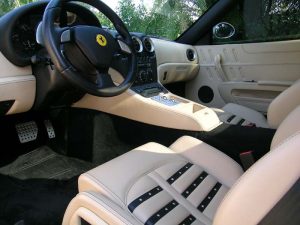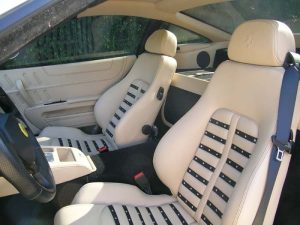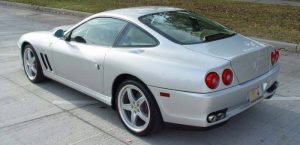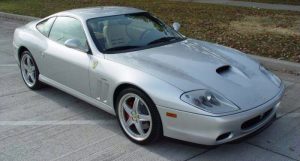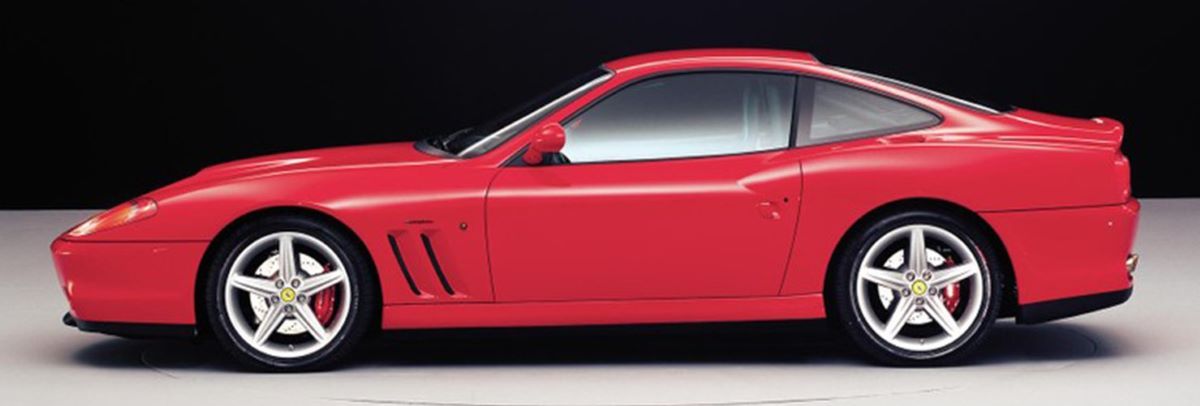
The 2003 575 M Maranello is the latest model produced by Ferrari and is an evolutionary successor to the 550 Maranello. It’s new code number, 575, refers to its increase in engine capacity from 5500 to around 5750 cc, which has resulted in increased power and torque.The letter “M” stands for “Modified,” underlining the fact that every area of the model’s performance has been worked on. The most obvious change is the introduction of an F1 type gear change; the first time this has been used on a road going 12 cylinder Ferrari.
In terms of styling, it was decided to retain the balance and sober looks of the 550, which invested it with the status of an instant classic, fitting in perfectly with Ferrari’s return to a front-engined high performance car.
The principal modifications were limited to those required to deal with the technical changes: in particular different shape and size for the air intakes in the new front end of the car and a new treatment for the front spoiler. The headlights and wheels have also been modified.
The interior of the 575M Maranello has been extensively revised, in order to make it more sporty and functional. In keeping with the car’s increased performance, the aim has been to improve the efficiency of how the driver controls the car.
The objectives fixed for the new V12 engine in the 575M Maranello were to increase both the power curve as well as the torque, when compared with the 550 Maranello. It now has a maximum power output of 515 CV (379 Kw) at 7250 rpm and maximum torque of 60 Kgm at 5250 rpm (588.6 Nm.) The optimum weight distribution, with a 50-50 split between the axles, with the driver on-board, has been achieved thanks to a transaxle design which features a combined rear mounted gearbox and differential unit with conical torque and autolocking differential in the same unit
The transmission on the new 575M Maranello is also fitted with the electro-hydraulic “F1” control unit mounted at the rear of the car, in order to minimise response time and to ensure a favourable operating temperature. The use of the F1 gearchange on the 575M Maranello has been developed specifically with the aim of reducing gearchange time and is integrated with the damping control, at the moment a gear is selected. One of the factors which has the biggest impact on the car’s road-holding is the new adaptive set-up, based on a system of independently controlled damping at all four corners of the car. The system is capable of selecting the ideal ride height for any condition, with two choices: Sport, which is selected for a more sporty ride, improving traction and Comfort, which gives a more comfortable ride, absorbing road bumps.
The braking has been modified to cope with the increased performance of the vehicle, especially in terms of avoiding fade and improving response under braking and the ABS/ASR system has been uprated from 5.0 to 5.3.
The 575M Maranello is also fitted with electronic pressure checking, using sensors, which means that tyre pressures can be checked while the car is on.
Ferrari’s GTC handling package
a new option on the 575M Maranello (the base price is $225,090 for models with the six-speed manual transmission, $235,539 with the F1 paddle-shift
the GTC package, which is named for Ferrari’s 575 GTC Le Mans-spec competition racing car, does provide some very nice options, most notably ceramic composite material (CCM) brake discs from Brembo. The equipment also includes nineteen-inch wheels with Pirelli P Zero Corsa competition rubber, a sport exhaust, and a firmer suspension setup (consisting of springs that are 35 percent stiffer in front and 15 percent stiffer at the rear, plus a 73-percent-stiffer rear antiroll bar) that had been offered heretofore as a $3600 “Fiorano” package.
Ferrari ceramic brakes aren’t noisy, a claim supported on the road and at Fiorano, where the brakes performed quietly, flawlessly. The GTC brakes allow the 575M Maranello to be driven-and stopped-hard all day long without “fading, thermal deformation, or disc wear” and with “wet efficiency.” Thanks go to a special brake cooling system, six-piston calipers in front, four-piston calipers in rear, and lightweight, ceramic composite discs with diameters of 15.7 inches in front and 14.2 at the rear and with thicknesses of nearly an inch and a half.
| 2003 Technical specifications | |
| Dimensions and weight Overall length: 179.13 in Overall width: 76.18 in Height: 50.27 in Wheelbase: 98.43 in Front track: 64.25 in Rear track: 62.44 in Kerb weight: 3,815 lbs Fuel capacity: 23 gallons (27,7 US gal) Tires Front: 255/40 ZR 18 Rear: 295/35 ZR 18 Brakes Front: 13 x 1.3 in Rear: 12.2 x 1.1 in |
Engine Bore/stroke: 89×77 mm 3.46×2.95 in. Unit displacement: 479 cc 27.8 cu. in Total displacement: 5,748 cc 334 cu. in Compression ratio: 11:1 Maximum power: 379 kW (515 bhp) @7,250 rpm Maximum torque: 588,6 Nm (60kgm) @5,250 rpm |
| Performance – Max. speed: 202 mph
Manual gearbox F1 gearbox |
|



